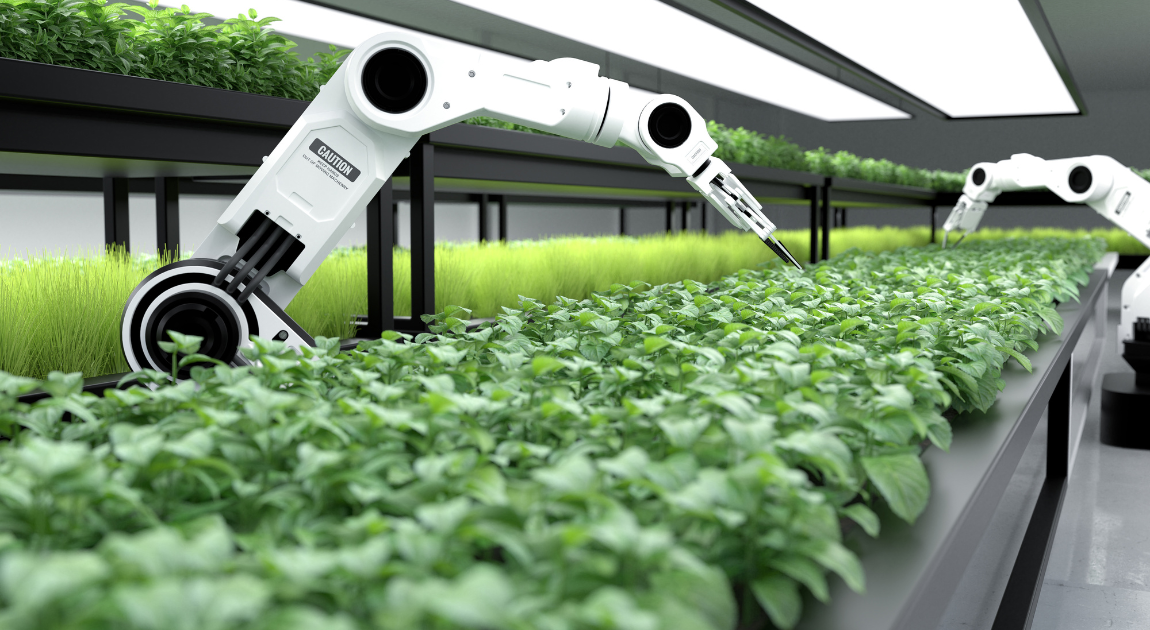Automation in general has been the lifeblood of business development in multiple fields. Agriculture, on the other hand, has always been one of the cornerstone industries that support economics of nations, so it’s only natural that the two should meet. The pathway for the infusion of latest tech into farming is open wide – and the results are quite spectacular. Here, we discuss the modern state of farm automation, what it’s all about, and what best practices have shown the best results so far.
What is farm automation?
In a way, the idea of automating agriculture has always been there, especially since the industrial revolution started and mechanical seed drills became a thing. While the initial couple of centuries, efficiency was the only concern, at a certain point, sustainability was added into the goal list. This might have been overwhelming, but digitization emerged at the right moment, thus spawning an entire field of innovation.
Farm automation today is a wide concept: in fact, it refers to the application of any tech to perform agricultural tasks while minimizing human intervention. Automatic irrigation, GPS-guided tractors, AI crop monitoring and drones all fall under this category.
Since the introduction of precision agriculture tools in the 1990, this evolution has taken the industry to data-driven decision making and robotics, and innovations are proliferating quite rapidly. According to a report by MarketsandMarkets, more than 60% of large-scale farms in North America and Europe have adopted at least one form of automation.
Importantly, farm automation has already passed the stage of disjointed systems and has started closing the gap between data, software, and physical tools, which is a promising trend for even better outputs.
Sustainability and the need for smarter agriculture
As mentioned, today’s agriculture is optimized not just for efficiency (that is, capability to meet the rising demand for produce) but sustainability, too. However, the former hasn’t disappeared, either. According to the UN, food production will need to increase by approximately 70% by 2050 to correspond to the projected 9.7 billion people. But simply expanding farmland or applying more inputs like this was done in the 1960s is no longer an option.
The good news, though, is that efficiency and sustainability are not inherently opposite “vectors”. When farm automation is combined with data analytics and IoT, making farming more efficient is actually achieved alongside sustainable practices. The key? Targeted action.
For example, smart irrigation can reduce water usage by up to 30%, while VRT (variable rate technology) allows farmers to apply fertilizers and pesticides precisely where they are needed, meaning the chemical runoff is lowered, and soil health is balanced. With livestock, animal health monitoring and feeding systems allow to use up the same amount of resources for a bigger herd.
Precision agriculture and what it requires
The drive toward precise, measured application of resources is what we now call precision agriculture – the practice of using tech to observe, measure, and respond to field variability. In other words, instead of wasting pesticides, water, or fertilizers simply because a field is a field, PA allows farmers to manage smaller sections based on what’s needed right there.
This would be next to impossible to do manually at a modern scale, but with automation, it’s more than achievable. The tech stack for this includes GPS and GNSS, remote sensing (drones, satellites), and IoT sensors, all coupled with VRT (variable rate technology). Drones can capture crop health indicators like NDVI, while sensors collect data on soil moisture, so that the VRT can adjust the input for each area in real time.
Finally, AI and data analytics help make sense of large datasets and predict outcomes, while suggesting the optimal course of action. For an illustration, you can look at one of the projects Lionwood.software did together with Agtellio here.
According to the USDA, farms that use precision agriculture tools can increase yields by 15–20% and reduce input costs by up to 30%. The EU’s Horizon 2020 research program has similarly shown that applying fertilizer variably, rather than uniformly, can cut usage by up to 40% without affecting crop health.
What’s especially neat about it is the scalability. Whether applied to 10 acres or 10,000, precision agriculture adapts to that. In this way, it’s no longer a world of large-operations enterprises with sophisticated machinery, but also smaller farms using affordable drone-based solutions and mobile apps.
Core technologies for farm automation
The array of technologies (and solution types) used for farm automation is truly great: the ideas of precision agriculture have been applied to almost every aspect of production from planting and irrigation to post-harvest logistics. All of them are some combination of hardware and software, and can be grouped based on the nature of that symbiosis.
Automated machinery and robotics
These include things like GPS-enabled tractors, robotic harvesters, and autonomous planters and are mostly oriented at minimizing the manual tasks. Good examples are auto-steering tractors on GNSS or robotic harvesters (for strawberries, tomatoes and the like this means faster harvesting due to the fact that robots can work longer hours than humans). The main advantage of this kind of tech is reduction in costs (which can be up to 40%).
IoT and sensor networks
Sensors placed in fields or greenhouses collect real-time data on soil moisture, nutrients, temperature of the ambient, and plant health indicators. These enable smart irrigation systems that water only where and when needed—resulting in up to 30% water savings (but the figures vary by location).
Imaging: drones, satellites
This is where scale is achieved with minimum investment. Drones equipped with multispectral cameras help detect crop stress, pest outbreaks, or irrigation issues early. For example, drone surveys can cover hundreds of acres per hour, and paired with AI, they can generate treatment maps for VRT sprayers.
Precision input systems (VRT)
Variable rate technology uses the data from sensors and imaging to manage the dispensation of fertilizers, seeds, and pesticides, which means it’s at the very heart of the process, and a lot depends on how good these systems are. The benefits are diverse. For instance, precision seeding improves plant spacing and reduces seed waste by 10–15%.
Farm management systems and analytics
Cloud-based platforms aggregate and analyze data from various sources—machinery, sensors, satellite feeds—and translate them into actionable insights. In a way, farm management systems have become the industry’s equivalent of what CRMs are in services and ERP in logistics – and just as diverse. Most popular features include:
- Crop planning tools
- Yield forecasting
- Automated reporting, and
- Compliance tracking
Post-harvest & supply chain automation
Since the field is, in turn, connected to the world outside (supply and demand at least), it’s only logical that businesses want to plug the farm automation capacities into the broader ecosystem. This is where intermediate tasks arise, as well as tech that helps with them: cold chain monitoring, automated packaging lines, and predictive logistics. For example, for perishable crops, automated sorting and grading systems are used to improve quality control and reduce post-harvest losses by up to 25%.
Benefits of farm automation software
The benefits of precision agriculture have been measured and documented quite extensively by both business intelligence agencies and governmental bodies. Since farm automation and AgTech in general is a major factor here, there is no shortage of data to really assess the advantages. However, the trick is to distinguish between the different locations and circumstances of application. The main benefits are:
- Increased productivity. It’s not just the derivative of getting rid of manual labor, but also the byproduct of digitization, since it’s now easier to streamline workflows and make things more precise. According to the USDA, automation technologies can increase agricultural productivity by up to 25%, particularly in row crops and greenhouse farming.
- Reduced waste of resources. For example, we’ve mentioned that smart irrigation reduces water use by up to 30%; fertilizers are saved by up to 20-40% thanks to VRT. Additionally, overapplication of chemicals is often detrimental to the soil quality, to put it mildly, so once that is reduced, the land itself gives a positive feedback loop.
- Better yields (quantity and quality). Farms using precision agriculture techniques have reported 15–20% yield improvements on average. Plus, early disease detection via drones or sensors can increase crop survival and reduce loss.
- Labor optimization. Especially in regions like North America and Europe, agricultural labor is not always in sufficient supply, so automating it is not always about “they’ve taken our jobs” problems. Additionally, robotics help reduce dependence on seasonal labor (harvesting, weeding).
- Environmental sustainability. Optimized machinery routes mean lower emissions, while precision pesticide use helps protect local biomes and overall biodiversity.
- Better data for strategic planning. Since automated systems collect real-time data anyway, it can also be used for trend analysis, risk management, and compliance.
The future of AgTech and farm automation
It is, of course, always difficult to predict the future exactly. Agricultural businesses function in a multi-variable environment, where tech is one variable, and then there are demographics, economic and geopolitical dark horses, not to mention the climate change and ecological factors. However, what we can trace forward at the moment paints a picture of the 2030s and 2040s that looks more or less like this:
Autonomous everything
Fully autonomous machinery is now a promising field, and a long-announced trend. In fact, companies like John Deere and AGCO are investing right now in self-driving tractors that can plow, plant, and harvest with AI-assisted navigation, while drone swarms are being tested for synchronized spraying and crop monitoring.
Even more AI in decision making
As AI is becoming more specialize-able and more affordable, we can expect that the work of dozens of startups developing decision-making engines and other AI for on-farm data analytics will yield its own crop.
Modular tech for smallholders
A major shift is also happening in accessibility. Scalable solutions that require less capital and infrastructure are being designed for small and medium-sized farms, which make up the majority of agricultural producers globally. Think plug-and-play IoT kits, mobile apps for crop monitoring, and solar-powered irrigation systems.
Climate resilience
With rising climate pressures, future AgTech will place a stronger focus on resilience and adaptation. Technologies like precision irrigation, drought-tolerant crop mapping, and carbon tracking tools will help mitigate risk and support global food security goals.
Blockchain for transparency
Traceability and transparency are becoming central to AgTech on the heel of regulations and even consumer trends. Blockchain-powered platforms can record the journey of produce from field to shelf, ensuring trust and meeting regulatory standards.
Whether you’re a large agricultural enterprise or a smallholder looking to scale sustainably, it’s a good idea to explore the tools that can transform your operation. At Lionwood.software, we specialize in building custom farm automation and AgTech solutions tailored to real-world needs, not just tech for tech’s sake. Contact us today to discuss how smart farming software can work for you.












